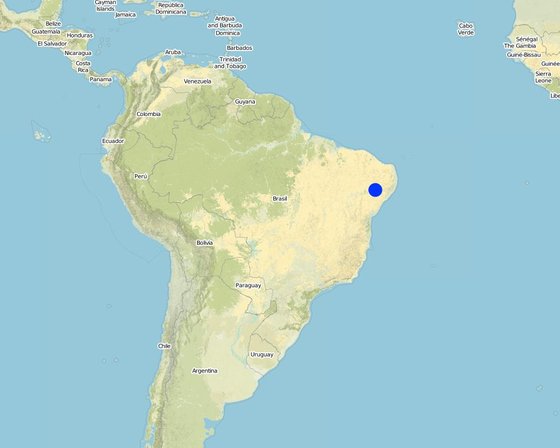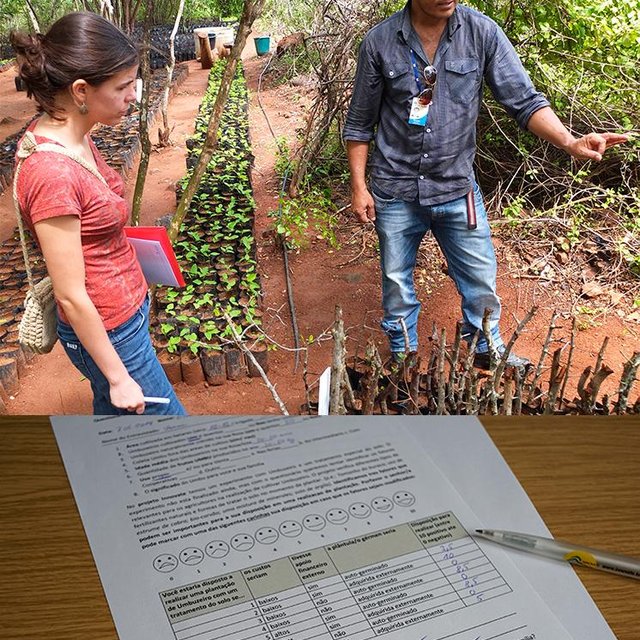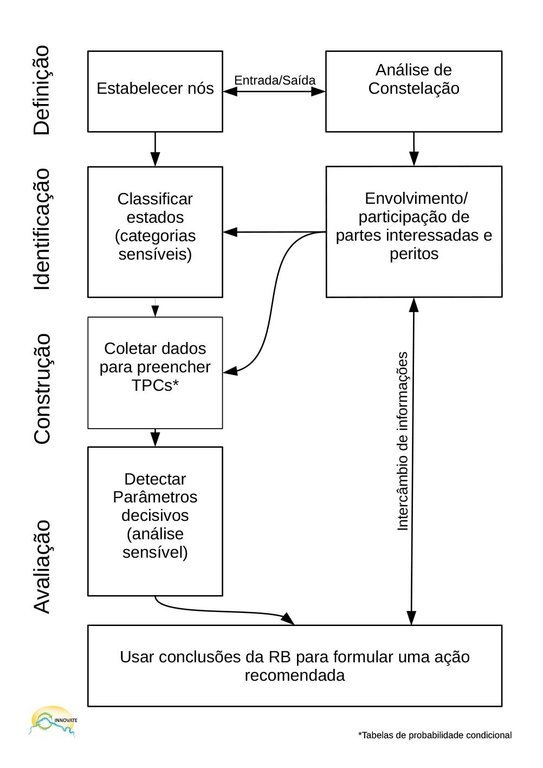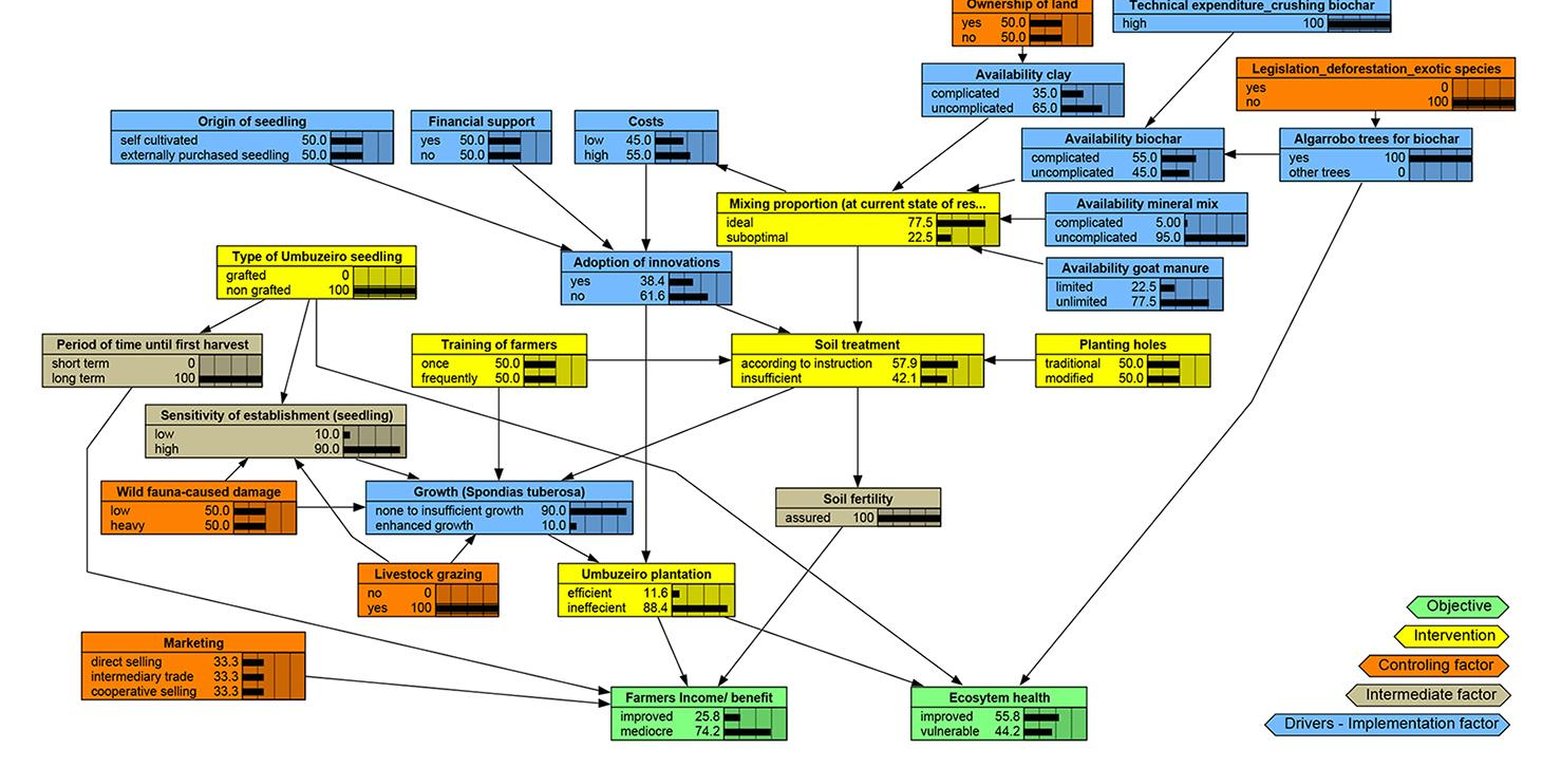Bayesian Network Approach
(Бразилия)
Abordagem com Redes Bayesianas
Описание
Assessment of the probability and effectiveness of management options or innovations to describe cause-effect-relationships and to make recommendations for action on sustainable land management in the Itaparica region in Northeast Brazil.
The study focus was on the determinants behind the adoption of innovations developed under a scientific project. The specific innovation analysed was intended to benefit both the environment and local smallholder farmers: namely cultivating a multi-purpose, low-growing, to the prevailing harsh semiarid environment well-adapted tree species (Spondias tuberosa L. – so called umbuzeiro). The assessment method was selected as it allows the combination of qualitative and quantitative data, and can be applied even in data-scarce situations. Moreover, it allows downscaling from a broad overview to small-scale management.
Knowledge is collected from different disciplines to support decision-making through the inter- and transdisciplinary approaches of constellation analysis and Bayesian networks. A Bayesian Network (BN) is a probabilistic graphical model that represents a set of variables (elements, nodes) and their conditional dependencies. There are three input components to a Bayesian Network: (a) a set of elements representing factors relevant to a particular environmental system or problem, (b) the links between these elements, and (c) the conditional probability tables (CPTs) behind each node (element) used to calculate the state of the node. Collected data and ratings are arranged in a hierarchical Bayesian Network model in Netica software (Netica 5.12 - freeware up to 15 nodes).
The creation of a Bayesian Network model is as follows: the objectives and necessary interventions for the innovation process aimed at sustainable management are characterized, with scientists arranging a conceptual diagram, including the mapping of elements. States of the nodes are determined through study of the literature and expert consultation (by scientists, stakeholders and experts on related topics). In a final step, a sensitivity analysis is performed on the Bayesian Network to highlight crucial nodes with the highest influence on objectives in order to derive actions to be recommended.
Stakeholder participation is the core process of designing Bayesian Networks. In pre-consultations stakeholders help identifying major influencing factors and relationships. Assessments are compiled in interview sessions enabling the states of the nodes to be quantified later. In this case study, the stakeholders were farmers, farmer-supporting institutions, and expert in soils, vegetation and crops.
Местоположение

Местоположение: Itaparica Reservoir, Petrolândia, Pernambuco, Brazil, Бразилия
Географическая привязка выбранных участков
Дата ввода в действие: 2014
Дата завершения: 2016
Тип Подхода
-
традиционная/ местная система землепользования, используемая коренным населением
-
недавняя местная инициатива/ инновация
-
в рамках проекта/ программы

Stakeholder interview in a fruit cooperative (above); Interview questionnaire (below) (Liron Steinmetz)
Цели подхода и благоприятные условия для его реализации
Главные цели/ задачи Подхода
The principle of Bayesian Network modelling is the integration of multiple issues and system components, where information from different sources can be integrated, while also handling missing data and uncertainty. The outcome may be recommendations that support local management decision-making. As the method is strong in transdisciplinary knowledge integration, it has the potential to become one of the core methods in environmental management.
Условия, содействующие применению Технологии/ Технологий в рамках Подхода
-
Социальные/ культурные/ религиозные нормы и ценности: None
-
Наличие/ доступность финансовых ресурсов и услуг: Potential for financial support could be through national small-scale farmer programs; suitable government-sponsored credit programs, public and governmental institutions such as bulk purchasers of agricultural commodities (for instance SEBRAE in Brazil).
-
Нормативно-правовая база (землевладение, права на земле- и водопользование): None
-
Осведомленность в области УЗП, доступность технической поддержки: Use available free programmes. Use of visual aids such as smileys for evaluation to make questionnaire more comprehensible.
Условия, затрудняющие применение Технологии/ Технологий в рамках Подхода
Участие и распределение ролей заинтересованных сторон
Заинтересованные стороны, участвующие в реализации Подхода, и их роли
| Какие заинтересованные стороны/ организации-исполнители участвовали в реализации Подхода? |
Перечислите заинтересованные стороны |
Опишите роли заинтересованных сторон |
| местные землепользователи/ местные сообщества |
Farmers of a resettlement community on dryland; Representatives of the indigenous tribe of Pankararu |
|
| эксперты по УЗП/ сельскому хозяйству |
Experts in soil and crop sciences; Expert in vegetation and biodiversity science of the Caatinga |
|
| государственные власти (отвечающие за планирование или принятие решений) |
Institute of Agriculture in Pernambuco (IPA); A private company as the hired institution by the National Institute for Colonization and Agrarian Reform - INCRA |
|
| Company of plant breeding, seed science |
|
|
Участие местных землепользователей/ местных сообществ на разных стадиях реализации Подхода
нет
пассивное
внешняя поддержка
интерактивное
самоорганизация
Схема реализации Подхода
Simplified work flow of Bayesian Network (BN) showing different steps:
Defining: apply or use already applied constellation analysis (see A_BRA003en) for information and visualization of node setting for the BN model and for stakeholder identification.
Identifying: clarify objectives, implementation factors, interventions, intermediates and controlling factors. Give every node a state, e.g. date, temperature range, amount of precipitation, or a classification: high / low…
Building: Collect data to fill the conditional probability tables (CPTs) behind every node. Prepare questionnaires, ask experts and conduct a literature search. Avoid too much states and no more than four nodes indicating the next node. Finish the model by entering all data in a programme (e.g. Netica).
Evaluating: Compare different scenarios by changing the state of inputs (e.g. from low to high). Show a baseline (without changes), a most improved and least improved scenario to justify recommendations. Finally, hand over recommended actions to stakeholders.

Автор: Liron Steinmetz, Verona Rodorff
Принятие решений по выбору Технологии УЗП
Решения принимались
-
исключительно землепользователи (по собственной инициативе)
-
в основном землепользователи при поддержке специалистов по УЗП
-
все участники как часть процесса совместных действий
-
преимущественно специалисты по УЗП после консультаций с землепользователями
-
исключительно специалисты по УЗП
-
политики/ руководители
-
The approach was initiated by scientists.
Принятие решений было основано на
-
анализ подробно описанного опыта и знаний по УЗП (принятие решений на основе подтвержденных фактов)
-
результаты исследований
-
личный опыт и мнения (незадокументированные)
Техническая поддержка, повышение компетенций и управление знаниями
Следующие мероприятия или работы являлись частью Подхода
-
Повышение компетенций/ обучение
-
Консультационные услуги
-
Институциональная (организационная) поддержка
-
Мониторинг и оценка
-
Научные исследования
Повышение компетенций/ обучение
Обучение было предоставлено следующим заинтересованным лицам
-
землепользователи
-
местный персонал/консультанты
Тип обучения
-
в ходе работы
-
обмен опытом между фермерами
-
опытные участки
-
общие собрания
-
курсы
-
workshops
Рассматриваемые темы
Detecting decisive factors for an ideal scenario of implementation being adopted by land users. For the participants it was interesting to participate in preparing a joint view of their action space - this is generally known in its parts though not with its major interconnections and complexity. Participants especially acknowledged this value added for them.
Институциональная поддержка
Какие институциональные структуры были укреплены или вновь созданы
-
нет
-
да, немного
-
да, умеренно
-
да, существенно
на уровне
-
местные
-
региональный
-
национальный
Опишите организацию, функции и ответственность, членство и т.д.
Decisive factors for the adoption of innovations were identified, including favoring cultivation techniques for Umbuzeiro agriculture (e.g. soil additives).
Тип поддержки
-
финансовая
-
повышение компетенций/ обучение
-
оборудование
Подробнее
Мониторинг и оценка
Научные исследования
Научные исследования проводились по следующим темам
-
социология
-
экономика / маркетинг
-
экология
-
технология
Research on the situation of local action and governance was a major driver for the workshops. University project members prepared and held the workshops, while also did extended interpretation and integration of results across a number of different workshops.
Финансирование и внешняя материальная поддержка
Годовой бюджет мероприятий по УЗП в долларах США
-
< 2000
-
2000-10000
-
10000-100000
-
100 000-1 000 000
-
> 1 000 000
Precise annual budget: н/п
German Federal Ministry of Education and Research (BMBF) 100%
Землепользователям были оказаны/предоставлены следующие услуги или меры стимулирования
-
Финансирование и внешняя материальная поддержка, предоставляемая землепользователям
-
Субсидии на отдельные затраты
-
Кредитование
-
Другие методы или инструменты стимулирования
Анализ влияния и заключительные положения
Влияние Подхода
Нет
Да, немного
Да, умеренно
Да, существенно
Сумел ли Подход помочь землепользователям внедрить и поддерживать технологии УЗП?
The different scenarios of the BN tested highlight the good probability of adoption, which then can support sustainable land management.
Сумел ли Подход расширить возможности социально и экономически уязвимых групп?
The approach was conducted especially for smallscale farmers without sophisticated irrigation tecniques and as well for the indigenous tribe Pankararu.
Сумел ли Подход разрешить правовые проблемы землевладения/ землепользования, препятствующие использованию технологий УЗП?
The BN model offers alternative sources for soil additives in case land use rights are hindering availability.
Сумел ли Подход способствовать улучшению продовольственой безопасности/ качества питания?
Not inmediately but a long-term influence is possible.
Did the Approach lead to improved livelihoods / human well-being?
The different scenarios of the BN tested highlight the good probability of adoption, which can then benefit the livelihoods of adopters.
Основные причины, побуждающие землепользователей внедрять УЗП
-
рост продуктивности
-
рост прибыли (доходности) и рентабельности
-
снижение деградации земель
-
снижение риска катастрофических погодных явлений
-
снижение объёма работ
-
материальное стимулирование/ субсидии
-
нормативно-правовое регулирование (штрафы)/ контроль
-
престиж, общественное давление/ солидарность
-
причастность к движению/ проекту/ группе/ сети
-
экологическая сознательность
-
традиции и верования, нравственные ценности
-
приобретение знаний и опыта в области УЗП
-
улучшение эстетической привлекательности
-
снижение остроты конфликтов
-
well-being and livelihoods improvement
Долгосрочная устойчивость мероприятий в рамках Подхода
Могут ли землепользователи самостоятельно (без внешней поддержки) продолжать применение того, что было реализовано в рамках Подхода?
Lessons learnt (especially on most favorable soil additive mixture) improve effectiveness of potential Umbuzeiro cultivation. Stakeholder pool of BN-creation comprises business networking opportunities for land users.
Заключительные положения и извлечённые уроки
Сильные стороны: по мнению землепользователей
Сильные стороны: по мнению составителя или ответственных специалистов
-
The combination of input variables from any given background is possible.
-
Via Bayesian networks changes to the modelled system can be tested prospectively. The space and potential effects of management options can be shown to decision makers.
-
Combining Bayesian networks with Constellation Analysis allows easy determination of major nodes of the model and supports the process of decision-making for sustainable land management activities; methods proved to be very transdisciplinary.
Слабые стороны/ недостатки/ риски: по мнению землепользователейвозможные пути преодоления
Слабые стороны/ недостатки/ риски: по мнению составителя или ответственных специалистоввозможные пути преодоления
-
The statistical component of the Bayesian network approach can be hard to grasp for less educated or near-illiterate stakeholder groups.
Percentages of probability estimations can be translated to a graphical equivalent (e.g. gradual scale of emoticons).
Справочные материалы
Продолжительность применения Технологии: 20 марта 2017 г.
Последнее обновление: 23 августа 2017 г.
Ответственные специалисты
-
Verena Rodorff (verena.rodorff@tu-berlin.de) - Специалист по УЗП
-
Marianna Siegmund-Schultze (m.siegmund-schultze@tu-berlin.de) - Специалист по УЗП
-
Liron Steinmetz (steinmetz@tu-berlin.de) - Специалист по УЗП
Полное описание в базе данных ВОКАТ
Документирование осуществлялось при участии
Организация
Проект
- Book project: Making sense of research for sustainable land management (GLUES)
Ключевые ссылки
-
Rodorff V., Steinmetz L., Siegmund-Schultze M., Köppel J. (2015) Using Bayesian networks to depict favouring frame conditions for sustainable land management: Umbuzeiro-tree planting by smallholders in Brazil: Session: Methods, tools and impact applications. Tropentag ‘Management of land use systems for enhanced food security - conflicts, controversies and resolutions’, September 16 – 18, 2015, Humboldt-Universität zu Berlin, Berlin, Germany
Ссылки на материалы по теме, доступные онлайн






